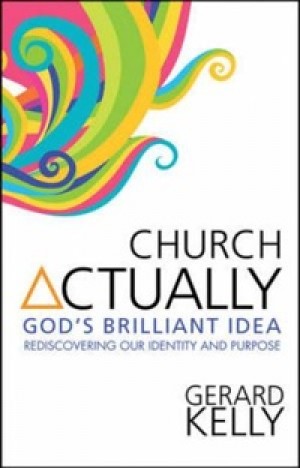In the final part of our serialisation, Gerard Kelly looks at what it means to be a gathered, worshipping people.
The other articles of this series are:
- 1. Church Actually: Perceiving colour and life
- 2. Church Actually: God's Four Brilliant Ideas
- 3. Church Actually: Recovering Our Story Again
- 4. Church Actually: How Then Should We Gather?

Ashley Campbell Photography
The third question that confronts us is just what the role should be, in our missional adventure, of the gathered and organized expression of church: that aspect of the church to which the adjective "institutional" is most often applied.
Contemporary students of mission are seeing increasingly that the church functions in both a gathered and a dispersed mode, and that it is in dispersal that the most effective mission takes place. They are learning to question the overemphasis, in the Christendom era, on gathering. They wonder if our highly organized, hierarchical and bureaucratic churches might not have become too heavy, too solid for the challenges of mission in a liquid culture. Might we not be better served, they ask, by a de-centred, grassroots movement networking together small and diverse gatherings of Christ-followers? Can't we make everything small and lo-fi, with flat, leaderless structures and organic and anarchic programmes?
Physical gathering was the only means by which belonging could be measuredOur current models of church have an inbuilt bias towards gathering, and much of our business is to do with community-building and personal growth. Many of the structures and programmes of our churches, from the recruitment and training of clergy to the planning of services and events, are calibrated towards this inward focus. There is a sense in which this emphasis on gathering is a hangover from the Christendom era, when belonging to the assembly of the church was fundamental to social identity: as vital as having an internet connection is today. Physical gathering was the only means by which belonging could be measured, and those in leadership of gathered churches were the unchallenged gatekeepers of salvation.
Such assumptions are being challenged and for the most part abandoned in a culture in which "assembly" is no longer a necessary measure of adherence. But there is another sense in which the instinct to gather, and by implication to organize, is intrinsic to the nature of church: the forming of church is by definition the forming of a new community.
The most eager advocates of a missional recalibration seem at times to be calling for the complete abandonment of the inward thrust, as if the outward call of mission can only be recovered through a wholesale turnaround. More conservative leaders – raised on the call to shepherd God's people; concerned with the in-gathering and formation of disciples – will tend to reject such a call out of hand, knowing that this inward-call is a necessary and significant part of what we are as people of faith. It seems that we are being asked to choose between inward focus and outward flow, between gathering and dispersal. This feels dangerously close to asking a dying patient if he would prefer to breathe in or breathe out. We can and must do both.
How much of the fact that we gather and our patterns of gathering is intrinsic to the nature of church, and how much of it is Christendom holding on to us? Much has been written on this subject in recent years – more deeply and eloquently than is possible here – but the result for some has been an unhealthy identification of the "gathered" church as an exclusively Christendom model and the "dispersed" or "incarnational" church as the only viable missional alternative – as if only dissolution can save us.
For my own part, I am not convinced by this case. The church that gave birth to Western civilization; that ushered in the Christendom era; that is now so fiercely in decline, was itself born in the outward thrust of the mission of God. Jesus is sent by the Father and sends his followers likewise. The Holy Spirit is sent from heaven to fall upon the church and to flow with them in an outward arc from Jerusalem to the ends of the earth. But wherever this outward-flowing movement interfaces with human culture, the church comes into being. Community is created and with community comes organization and leadership; plans and strategies and budgets; conflicts and divisions and political processes. The "sending-out" movement of God's mission creates the "drawing-in" movement of the church. As a friend recently commented on Twitter, God sends to gather and gathers to send.
How can the church be at the centre of the action without becoming the centre of attention?I find myself asking if a more nuanced process of change might not be possible, charting a course from where we are now to where we need to be without losing the beauty and significance of church as we have known it. The central question for me is not "Should the church be gathered or dispersed?" but rather, "How does the gathered expression of church resource its missional dispersion?"
In Get a Grip on the Future, published in 1998, I explored the changing face of Western culture and the potential for mission to adapt to a post-industrial, post-literate, post-modern, post-imperial and post-Christian future. Since then I have engaged in conversation and dialogue with many key thinkers in the "emergent" and "missional" movements, while at the same time, through the Bless Network, encouraging young people to engage in acts of missional service with established denominations alongside existing, mainstream congregations. Church Actually is an attempt to take this twin commitment further, and to ask how the gathered church can once more take its place at the very heart of God's mission in the world. How can the church be at the centre of the action without becoming the centre of attention? How can it harness the resources of the people of God for the sake of mission without drawing those resources to itself? Can we unite for liquidity without creating a deathly solidity?
These three questions – of the transmission of faith in the cultures of the West, of the recovery of a truly missional church and of the bringing together of gathered and dispersed models of mission – have challenged my thinking over thirty years of mission and given rise to the model of faith here presented as Church Actually – a model of faith and mission for the twenty- first century that breathes both out and in; that is unashamedly attractional and passionately incarnational; that delights to be gathered and longs to be dispersed; that is organizationally strong but hugely equipping of its individual members; that has immense strength at its centre and unfettered openness at its edge. I want to suggest that in our quest for such a church there are colours we will need to recover; wavelengths of God's mission to which we have perhaps become blind.
It is significant that science, and not aesthetics alone, played a part in shaping the work of the Fauvists and the colour-revolution they gladly joined. Their work was, in part, a response to changes in their cultural landscape.

In the closing years of the nineteenth century and the early years of the twentieth, two areas of research were moving ahead at such a pace as to make new experiments in art not only possible but inevitable. The first was the development of photography and the associated experimentation in the behaviour of light. Early discoveries in photographic processing showed as never before the relationship between sight and light and revealed much that had never before been so fully understood. This led to discoveries about refraction and the nature of colour that gave avant-garde artists new confidence in their experimentation. They were freed to "see" more than they had ever seen before, understanding that the light pouring into their eyes carried many more colours than their rational minds had previously acknowledged.
In parallel to this, developments in the manufacture and import of pigments were offering to the painter unprecedented power to reproduce the colours he was seeing. Year by year new pigments became available or affordable, and each one added to the artist's armoury. The Impressionists, most notably Monet, were the first to take advantage of these developments and break into new areas of experimentation with colour. The journey was taken further by the post-Impressionists and by Seurat and the Pointillists – who painted by applying thousands of tiny dots of disparate colours – until the baton was passed to the Fauvists and beyond.
All in all, the art world of the late nineteenth and early twentieth centuries was a carnival of colour: a global celebration of polychromatic light. As representatives of this period, Matisse and Derain, honoured to this day in the town of Collioure, stand as ambassadors of colour – prophets of a technicolour future. The wildness of their paintings should not be dismissed as naive and over-imaginative playfulness: it is underpinned by a deep and essentially scientific interaction with colour. The Fauves are not Surrealists. They are not trying to tell us what they have dreamed or imagined. They are trying to tell us what they see. Colour, for them, is reality. It is our paler, more monochrome view that is imagined, imposed on our vision by a cold rationalism that insists on informing us that stone "is" grey. Derain and Matisse want to break open the limited and limiting perceptions that dull our senses. They are artists engaging with a changing world. They want to free us to see all the colours light has for us.
Can you hear the Holy Spirit, through them, calling you to a fuller vision of the church?
Taken from Church Actually by Gerard Kelly, published by Monarch Books. Buy Church Actually now at Eden.co.uk.
March 23rd, 2012 - Posted & Written by The Editor














Did you find this comment useful?